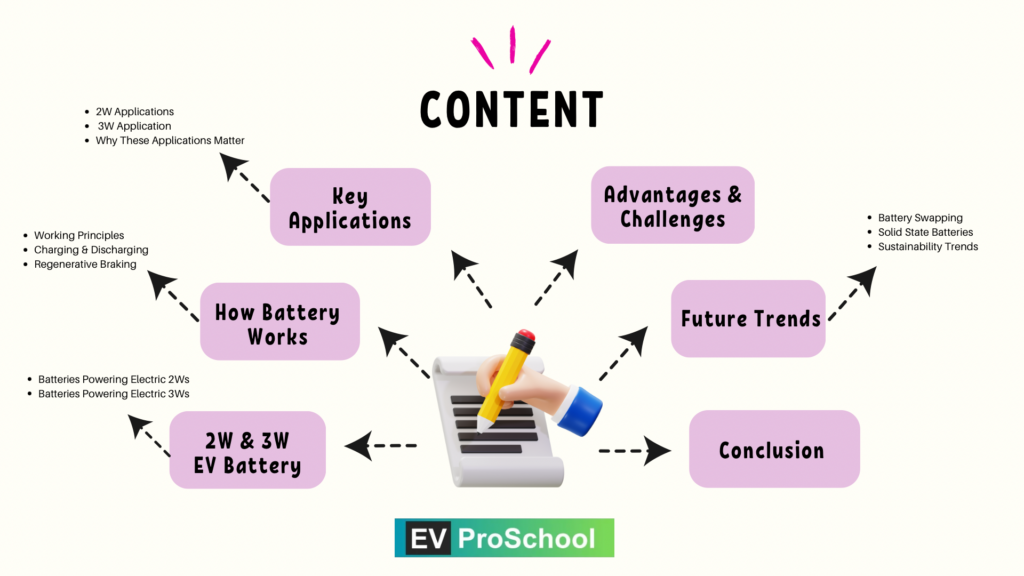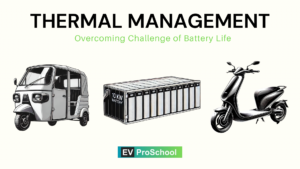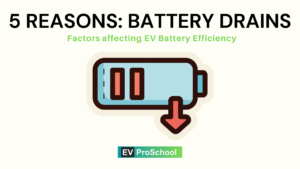Introduction: Why 2W and 3W EV Batteries Matter
- Hook the reader:
“Did you know that over 50% of the world’s vehicles are two- and three-wheelers? As electrification rises, understanding how these smaller but powerful EV batteries work is key to embracing a cleaner future.” - Set the context: Explain the growing popularity of 2W and 3W EVs due to affordability, efficiency, and eco-friendliness.
- Preview the blog: Mention that this post will break down the structure, working principles, and key applications of 2W/3W EV batteries.

What Are 2W and 3W EV Batteries?
- Define what 2W and 3W EV batteries are.
- Batteries powering electric two-wheelers (like scooters and bikes).
- Batteries for three-wheelers (e.g., e-rickshaws, cargo vehicles).
- Why Are They Important?
- 2W/3W EVs dominate in developing countries like India and Southeast Asia.
- They offer cost-effective and eco-friendly transport.
Basic Structure of 2W & 3W EV Batteries
- Battery Type:
- Predominantly lithium-ion batteries (Li-ion) due to their energy density, light weight, and longer lifespan.
- Occasionally lead-acid batteries (in low-cost models).
- Components of a 2W/3W EV Battery:
- Cells: Small units that store and discharge energy.
- Battery Management System (BMS): Monitors and regulates battery performance.
- Casing: Protects the battery from physical damage and water.
- Cooling Systems: Keeps battery temperature in check, ensuring safe operation.
- Visual Idea: A labeled diagram of a 2W/3W battery pack with components like cells, BMS, and cooling systems.
How 2W & 3W EV Batteries Work?
- Working Principles:
- Batteries store electrical energy (typically in Li-ion cells).
- This energy powers the electric motor, which drives the wheels.
- The BMS ensures optimal charging, discharging, and safety.
- Charging and Discharging:
- Charging via wall chargers or fast chargers.
- Discharge rate affects range and performance.
- Regenerative Braking:
- Some 2W/3W EVs recover energy during braking to improve efficiency.
Key Applications
- 2W Applications:
- Electric scooters, bikes, and motorcycles for personal and short-distance commuting.
- Examples: Ola S1, Ather 450X, TVS iQube.
- 3W Applications:
- E-rickshaws for passenger transport.
- Cargo three-wheelers for last-mile delivery.
- Examples: Mahindra Treo, Piaggio Ape E-City.
- Why These Applications Matter:
- Reduce reliance on fossil fuels.
- Address air pollution in urban areas.
- Cost-efficient transportation in densely populated regions.
Advantages and Challenges
- Advantages:
- Lightweight and compact design.
- Affordable for mass adoption.
- High energy efficiency compared to petrol-powered alternatives.
- Challenges:
- Limited range (~60-150 km per charge).
- Longer charging times in budget models.
- Battery recycling and end-of-life management still evolving.
Future Trends in 2W & 3W EV Batteries
- Battery Swapping:
- Batteries are swapped instead of recharged, minimizing downtime.
- Popular for 3W EVs in regions like India and China.
- Solid-State Batteries:
- Emerging technology offering higher energy density and faster charging.
- Sustainability Trends:
- Efforts to recycle and reuse EV batteries effectively.
- Reducing reliance on cobalt and other rare materials.
Conclusion
- Summarize the importance of 2W/3W EV batteries in the transition to clean transportation.
- Reiterate their benefits and potential for transforming urban mobility.
- End with a call-to-action:
“Are you considering switching to a 2W or 3W EV? Stay updated on battery trends and innovations with our blog!”
3. Writing Style and Tone
- Tone: Informative yet conversational to appeal to both EV enthusiasts and beginners.
- Use relatable analogies:
- “Think of the BMS as the battery’s brain, constantly monitoring and controlling its performance.”
4. Suggested Visuals and Graphics
- Diagram: Cross-section of a 2W/3W EV battery pack.
- Infographic: Comparison of Li-ion vs lead-acid batteries for 2W/3W EVs.
- Bar Graph: Growth of 2W/3W EV adoption in different countries.
- Real-Life Images: Popular 2W/3W EV models with battery specs.
5. SEO Optimization Strategy
Focus Keyword:
2W and 3W EV batteries
Supporting Keywords:
- Two-wheeler EV battery
- Three-wheeler battery basics
- Electric scooter battery
- E-rickshaw batteries
- Affordable EV batteries
Meta Description:
“Learn the basics of 2W and 3W EV batteries! Discover their structure, working principles, and real-world applications powering scooters, bikes, and e-rickshaws worldwide.”
Content Optimization:
- Use the focus keyword in:
- Title (H1), Subheadings (H2, H3), and throughout the body (3-5 times).
- Meta description and image alt texts.
- Add internal links to related blogs (e.g., “Understanding EV Battery Efficiency”).
- Include external links to credible sources like EV manufacturers or battery innovators.
6. Blog Length
- Target: 1,500–1,800 words to provide a comprehensive yet focused explanation.
By following this strategy, you’ll create an engaging, SEO-optimized blog post that educates readers on the fundamentals of 2W/3W EV batteries while positioning your blog as a trusted source for EV knowledge.
Imagine a toddler trying to get down from a bed that’s a bit too high. They know there’s a risk of falling, so they come up with a plan. First, they assess the danger and realize it’s a little too risky to just jump. Then they look around, find a stack of pillows, and pile them up to create a soft landing. Problem solved—safe and sound!
Step 1: Identify and Study the Risk
Step 2: Review Possible Solutions
Step 3: Apply the Solution
Step 4: Check and Make Any Changes
Step 5: Take Action
Risk management for 2W and 3W EV batteries works in a similar way. Let’s break it down step-by-step:
Step 1: Identify and Study the Risk
Just like the toddler realizes the height of the bed is risky, we start by identifying the potential dangers with EV batteries—thermal runaway, overcharging, mechanical damage, and so on.
These risks include:

- Thermal Runaway: Lithium-ion batteries can overheat, leading to thermal runaway, which can cause fires or explosions.
- Overcharging and Over-discharging: Poor battery management systems (BMS) can lead to overcharging or over-discharging, degrading battery health and increasing the risk of damage.
- Cell Imbalance: Uneven charging or discharging of cells can create imbalance, reducing battery efficiency and lifespan.
- Mechanical Damage: Vibration or physical impact from rough roads or accidents can damage battery cells, leading to safety hazards.
- Environmental Factors: Extreme temperatures, humidity, or water exposure can degrade battery performance or cause malfunctions.
- Charging Infrastructure: Lack of proper charging infrastructure can lead to unsafe charging practices, increasing risk.
- Battery Aging: As batteries age, their capacity to hold charge diminishes, leading to a reduction in performance and increased likelihood of malfunction.
By conducting thorough research and analyzing case studies, manufacturers, and operators can better understand these risks and their potential impact on battery performance and vehicle safety.
Step 2: Review Possible Solutions
Now, just as the toddler stacks up pillows for a soft landing, we look for ways to minimize risk. This includes adding safety features like advanced battery management systems, thermal management solutions, and durable enclosures to keep the battery safe from damage.
Here are some approaches for Potantial Solutions:
- Regular Monitoring and Maintenance: Routine battery health checks can help detect early signs of degradation, allowing timely intervention to prevent failures.
- Advanced Battery Management Systems (BMS): A sophisticated BMS ensures optimal charging, monitors temperature, prevents overcharging or over-discharging, and maintains cell balance.
- Thermal Management Systems: Efficient cooling systems are essential for preventing overheating and mitigating thermal runaway risks.
- Durable Battery Enclosures: Using robust materials and designs for the battery housing can protect cells from mechanical damage due to shocks, vibrations, or accidents.
- Waterproofing and Insulation: Protecting batteries from moisture and extreme temperatures can improve reliability and lifespan.
- Charging Standards and Guidelines: Providing clear guidelines and developing safe charging infrastructure can minimize charging-related risks.
- Cell Chemistry Innovations: Exploring new chemistries such as solid-state batteries or lithium iron phosphate (LFP) can improve safety by reducing flammability and thermal runaway risks.

By reviewing these solutions, manufacturers and operators can choose the best strategies to address each specific risk
Step 3: Apply the Solution
The toddler climbs down onto the pillow stack. Similarly, we apply our solutions—installing reliable BMS, optimizing the battery design, and ensuring safe charging infrastructure—to protect the battery from harm.
After selecting the appropriate solutions, the next step is to implement them. Applying these solutions involves:
- Optimizing Battery Design: Incorporating advanced BMS, thermal management, and rugged enclosures into the design of 2W and 3W EV batteries.
- Installing Reliable Charging Infrastructure: Providing access to safe, standardized charging stations that minimize the risk of overcharging or damage to the battery.
- Training Operators: Educating fleet operators and EV users on safe battery handling, maintenance, and charging practices.
- Regulatory Compliance: Ensuring that all solutions comply with national and international standards for EV battery safety and performance.

Effective implementation requires close collaboration between battery manufacturers, vehicle OEMs, and operators, ensuring that all safety and performance standards are met.
Step 4: Check and Make Any Changes
After the first jump, the toddler might adjust the pillows if it’s not quite right. In the same way, we monitor our EV batteries to ensure everything’s working as expected, making any necessary adjustments.
This step involves:
- Data Monitoring: Using sensors and telematics to collect real-time data on battery performance, such as temperature, voltage, and charge/discharge rates.
- Audits and Inspections: Conducting regular audits and physical inspections to ensure that the batteries are performing as expected and that no new risks have emerged.
- Feedback Loops: Gathering feedback from users and operators to identify any ongoing issues or concerns that may have been overlooked during the initial solution application.
- Comparative Analysis: Comparing the current battery performance data with historical records to detect improvements or declines.

If any discrepancies or issues are identified, immediate adjustments should be made to optimize battery performance and safety.
Step 5: Take Action
If all goes well, the toddler knows this method works and sticks with it. For EV batteries, if the solution proves effective, we scale it up, ensure it’s applied across the board, and take any further action needed to improve long-term safety.
Taking corrective or preventive actions based on the results from the previous step. Actions may include:
- Adjusting Operational Protocols: Modifying charging schedules, handling practices, or maintenance routines to better protect battery health.
- Upgrading Components: If certain components, such as cooling systems or BMS, are found to be underperforming, they may need to be replaced with more effective alternatives.
- Scaling Solutions: If the applied solutions prove effective, they should be scaled across the entire fleet or product line to ensure uniform safety and performance.
- Research and Development: Continuously investing in R&D to find new materials, technologies, or processes that further reduce risk and improve battery performance.
By taking proactive action, manufacturers and operators can stay ahead of potential risks and ensure long-term battery safety and reliability.
Conclusion
Just like the toddler’s thoughtful approach to getting down from the bed safely, managing risks for 2W & 3W EV batteries involves careful planning and smart solutions. With this approach, we can ensure EV batteries are safe, efficient, and long-lasting.



